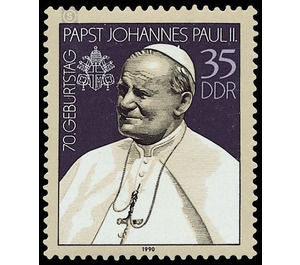70th Birthday - Germany / German Democratic Republic 1990 - 35 Pfennig
Theme: Post & Philately
| Country | Germany / German Democratic Republic |
| Issue Date | 1990 |
| Face Value | 35.00 |
| Color | brown |
| Perforation | K 14 |
| Printing Type | offset |
| Stamp Type | Postage stamp |
| Item Type | Stamp |
| Chronological Issue Number | 3079 |
| Chronological Chapter | GER-DDR |
| SID | 834734 |
| In 18 Wishlists | |
70th birthday of Pope John Paul II On the occasion of the 70th birthday of Pope John Paul II, the Ministry of Posts and Telecommunications of the German Democratic Republic issued a multicolored special postage stamp. Special Cancellation from May 15 to July 14, 1990 Pope John Paul II - 70th Birthday The archbishop of the Polish archdiocese of Krakow, Karol Wojtyla, was elected head of the Roman Catholic Church on October 16, 1978, by 111 cardinals assembled in the Vatican. The new pope took the name of John Paul II. His motto is "Totus tuus - all yours." Cardinal Wojtyla became the first non-Italian bishop of Rome and pope of the Roman Catholic Church after 455 years, and the papal coat of arms of John Paul II corresponds to the heraldic basic pattern of the coats of arms Papal coats of arms are coats of arms and have the peculiarity that the coat of arms of the ruling Pope is also the coat of arms of the Vatican State for the duration of his pontificate The Tiara consists of an originally white cap with three golden crowns standing one above the other and the orb of the imperial ori- gin - the last pope to join the popes the introduction to his office was Paul VI (1963-197 8), he dedicated his tiara in 1964 to the poor. His successors, John Paul I (1978) and John Paul II, rejected the tiara and confined themselves to the pallium as a sign of their dignity, as had been customary before the coronation. The tiara remained as a traditional symbol, however, continue in the arms of both popes. In the arms of John Paul II, which is spanned by the Christian symbol of the cross, there is an M, the initial letter of the name of Mary, the mother of Jesus Christ. Karol Wojtyla was born on May 18, 1920 in Wadowice near Krakow. His father was a worker. He first studied philology at the University of Krakow. During the Nazi occupation of Poland, he worked in a chemical plant. Despite an explicit ban on the Nazi regime, in 1942 he began to study theology in addition to his work. He was ordained a priest in 1946. He continued his studies in Rome. He obtained his doctorate in 1948 and habilitated in 1953 and began teaching at the Philosophical Faculty of the Catholic University of Lublin. On September 28, 1958 Karol Wojtyla received episcopal ordination, was auxiliary bishop in Krakow and in 1964 became archbishop of this archdiocese. In 1967 he was Pope Paul VI. appointed to the College of Cardinals. The pontificate of John Paul II is marked by a global sense of responsibility for humanity, justice and peace, which goes far beyond the scope of his ecclesiastical and religious administration. His moral authority is recognized worldwide. His pastoral journeys to all regions of the world, especially to the poorest of the poor, as well as his numerous encounters with the leading statesmen from all over the world, serve the one goal: to bring about an ever more human world for all people and peoples.


